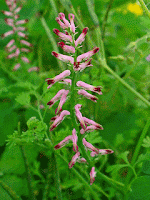There are many types of fumitory, but here we deal with the one which is used in medicine Fumaria officinalis. It gets its English name from the Latin (and French) fume-terre, or earth-smoke. It actually looks smoky, with its grey-green leaves and legend has it that it grew, not from seed but from vapours that came from the ground (as with hot springs
 The plant is in the Fumariaceae family and fumitory of one kind or another grows in most parts of the world including
The plant is in the Fumariaceae family and fumitory of one kind or another grows in most parts of the world including  In the 14th century, Geoffrey Chaucer wrote about it in his “Canterbury Tales” and in The Nun’s Priest’s Tale it is listed as a laxative:-
In the 14th century, Geoffrey Chaucer wrote about it in his “Canterbury Tales” and in The Nun’s Priest’s Tale it is listed as a laxative:- “…ere ye take your laxatives
Of lauriol, century, and fumitory,
Or elles of elder bery that growith thereby,
Of catapus or of dogwood berrys
Of yvy in our yard, that mery is:”
Dioscorides writing in the first century AD believed that it was good for cleansing the blood and as a tonic, but as we can see from Chaucer and later writers, it was used with an infusion of senna as a laxative.
Shakespeare makes mention of fumitory too, and classifies it as a “rank” weed, as we can see from Cordelia’s speech in “King Lear” Act IV scene 4 when she is talking about her mad father, the king, describing him in these words: -
“As mad as the vexed sea, singing aloud,
Crown’d with rank Fumiter and Furrow-weed,
Darnel and all the idle weeds that grow
In our sustaining corn.”
 Furrow weeds were any type of weed that grew in ploughed land and darnel were also any type of weed, although these may have been thistle-types. Clearly Shakespeare didn’t think much of fumitory as in Henry V he once again classifies it as “rank” in Act V scene 2 :-
Furrow weeds were any type of weed that grew in ploughed land and darnel were also any type of weed, although these may have been thistle-types. Clearly Shakespeare didn’t think much of fumitory as in Henry V he once again classifies it as “rank” in Act V scene 2 :- “Her fallow leas
The Darnel, Hemlock and rank Fumitory
Doth root upon.”
Interestingly, Nicholas Culpeper in his Herbal wrote that it can banish Melancholy but warns against taking the pills in large doses over a period of time. He quotes Ibn Sina or Avicenna thus: -
“Pills of Fumitory: Take of myrobalans, citrons, chebs and Indian Diagrydium of each 5 drams; Aloes 7 drams; let all of them be bruised, be thrice moistened with the juice of Fumitory and thrice suffered to dry, then brought into a mass with a syrup of Fumitory.” Culpeper adds “It purges Melancholy. Be not too busy with it I beseech you.”
He writes that fumitory has cooling properties along with strawberry leaves, wood sorrel, teazles and houseleeks among other plants for the head, and writes that it is “Cold in the second degree” as are plantain, chicory (Succory), and strawberry leaves and also states that it is good for the spleen. He suggested it be mixed with vinegar and docks and used as a wash for skin problems such as sores, scabs and pimples. (The old herbalists believed that fumitory could help with all skin problems including leprous sores.)
Fumitory flowers in summer and a yellow dye can be obtained from the flowering tops. These are also the parts used in medicines as well as the seeds of this plant. One old (and rather expensive remedy these days) is to macerate 2 ounces of the flowers and tops in 2 pints (the expensive part) of Madeira and this was to be taken twice a day for dyspepsia. The dose was 2 to 4 fluid ounces.
 Fumitory flowering tops may be gathered in summer and dried for later use as they are thought to be especially useful for obstructions in the liver, kidneys, gall bladder and spleen. In
Fumitory flowering tops may be gathered in summer and dried for later use as they are thought to be especially useful for obstructions in the liver, kidneys, gall bladder and spleen. In However caution should be taken with this herb because one can have too much of it for comfort.





